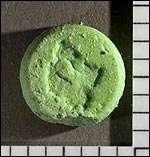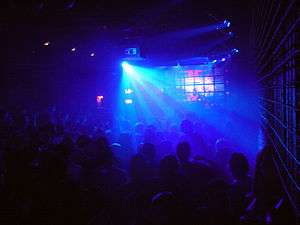Club drug
Club drugs, also called rave drugs, or party drugs are a loosely defined category of recreational drugs which are associated with discothèques in the 1970s and dance clubs, parties, and raves in the 1980s to the 2000s.[1] Unlike many other categories, such as opiates, which are established according to pharmaceutical properties, club drugs are a "category of convenience" which includes drugs ranging from entactogens and inhalants to stimulants and psychedelics. Dancers at all-night parties have used these drugs for their stimulating or psychedelic properties. "Club drugs" vary by country and region; in some areas, even opiates such as heroin have been sold at clubs, though this practice is relatively uncommon.[2]
Types

Examples of drugs typically categorized as club drugs include MDMA (ecstasy), various amphetamines and the depressant GHB (also a date rape drug) and the dissociative anesthetic ketamine. 'Poppers' is the street name for a group of simple alkyl nitrites (the most well-known being amyl nitrite), which are clear, yellow volatile liquids which are inhaled for their intoxicating effects. Nitrites originally came as small glass capsules that were popped open, which led to the nickname "poppers." The drug became popular in the US first on the disco/club scene of the 1970s and then at dance and rave venues in the 1980s and 1990s. The "club drugs" vary by country and region. In Delaware, heroin (and many other drugs) are sold at clubs and at raves. Though far less common than other "club drugs" like MDMA, ketamine, or LSD, heroin can be found in some of New York's clubs.
Although the previously mentioned selection of drugs are generally categorized as club drugs by the media and the United States government, this distinction probably does not have an accurate correlation to real usage patterns. For example, alcohol is generally not included under the category of club drugs, even though it is probably used more than any other drug at clubs. Ketamine has long history of being used in clubs and was one of the most popular substances used in the New York Club Kid scene. Ketamine produces a dissociative state, characterized by a sense of detachment from one's physical body and the external world which is known as depersonalization and derealization. Effects include hallucinations, changes in the perception of distances, relative scale, color and durations/time, as well as a slowing of the visual system's ability to update what the user is seeing.
In the 2000s, synthetic phenethylamines such as 2C-I, 2C-B and DOB have been referred to as club drugs due to their stimulating and psychedelic nature (and their chemical relationship with MDMA).[3] By late 2012, derivates of the psychedelic 2C-X drugs, the NBOMes and especially 25I-NBOMe, had become common at raves in Europe.
Effects
Each different club drug offers a different effect. Increased heart rate, a steep increase in body temperature, increase in blood pressure, spasms and dehydration are all common side effects of MDMA and Methamphetamine. Other club drugs have hallucinogenic effects and sedative effects. Drugs like LSD, Ketamine, GHB and Rohypnol demonstrate this. Breathing and respiratory issues, drowsiness, nausea and confusion are common side effects of said drugs. All club drugs have some common effects. They often make the user anxious, stressed and panicked. They can lose memory and hallucinate. The shift in behaviour is dramatic and they can too lose control (Federal Bureau of Investigation, n.d).
History
In the mid- to late-1970s disco club scene, there was a thriving drug subculture, particularly for drugs that would enhance the experience of dancing to the loud dance music and the flashing lights on the dancefloor, such as cocaine[4] (nicknamed "blow"), amyl nitrite ("poppers"),[5] MDMA, Amphetamine, and the "...other quintessential 1970s club drug Quaalude, which suspended motor coordination."[6] According to Peter Braunstein, "massive quantities of drugs were ingested in discothèques." Throughout the 1980s, the use of club drugs expanded from being used in discothèques to being used recreationally, in college campuses, parties and at times, when alone. As time passed, club drugs appeared at raves (EcstasyAbuse.com, 2014). Much like a discothèque, raves made use of flashing lights, loud techno/dance music to enhance the users experience. They were often advertised as alcohol free and drug free to attract the attention of the young crowd and instilling trust and relief between parents and their children. But it was at these venues; club drugs were sold and used to a greater extent (Federal Bureau of Investigation, n.d).
Nowadays, the use of club drugs has diminished slightly as people are becoming more aware of the negative effects and dangerous situations they may bring about. Law officials monitor the dealing and usage more closely. Also, professional help is easier to find in today's society, be it online, by phone or in person (Federal Bureau of Investigation, n.d).
In Australia
It is well known that club drugs are used in Australia, as it is something commonly reported. There are many different Australian statistics using the variety of club drugs. It is shown that one in ten Australians has used MDMA at least once in their lifetime, however one in thirty have used MDMA in the past 12 months. One in a hundred Australians has used Ketamine at least once in their lives and a total of five hundred in the past 12 months. One in two hundred Australians have used GSB at least once in their lives and one in one thousand in the past 12 months. Regarding the entire Australian population, seven per cent of Australians have used cocaine at least once in their lifetime and two per cent of Australians have used it in the past 12 months (Australia Defence Force (ADF), n.d). In today’s generations, through teens, young adults and mature aged people, these drugs are a common attribute to nightclubs and pubs. For this reason they are used popularly throughout Australia.
See also
- Party pills
- Rave
- Route 36, world's first cocaine bar
References
- ↑
- ↑ http://www.ncjrs.gov/txtfiles/p_5wpuls.txt
- ↑
- ↑ Gootenberg, Paul (1954). Between Coca and Cocaine: A Century or More of, pp. 119–150. He says that, "The relationship of cocaine to 1970s disco culture cannot be stressed enough; ...".
- ↑ Amyl, butyl and isobutyl nitrite (collectively known as alkyl nitrites) are clear, yellow liquids which are inhaled for their intoxicating effects. Nitrites originally came as small glass capsules that were popped open. This led to nitrites being given the name 'poppers' but this form of the drug is rarely found in the UK The drug became popular in the UK first on the disco/club scene of the 1970s and then at dance and rave venues in the 1980s and 1990s. Available at: http://www.drugscope.org.uk/druginfo/drugsearch/ds_results.asp?file=%5Cwip%5C11%5C1%5C1%5Cnitrites.html
- ↑ http://www.americanheritage.com/articles/magazine/ah/1999/7/1999_7_43.shtml – 76k -
